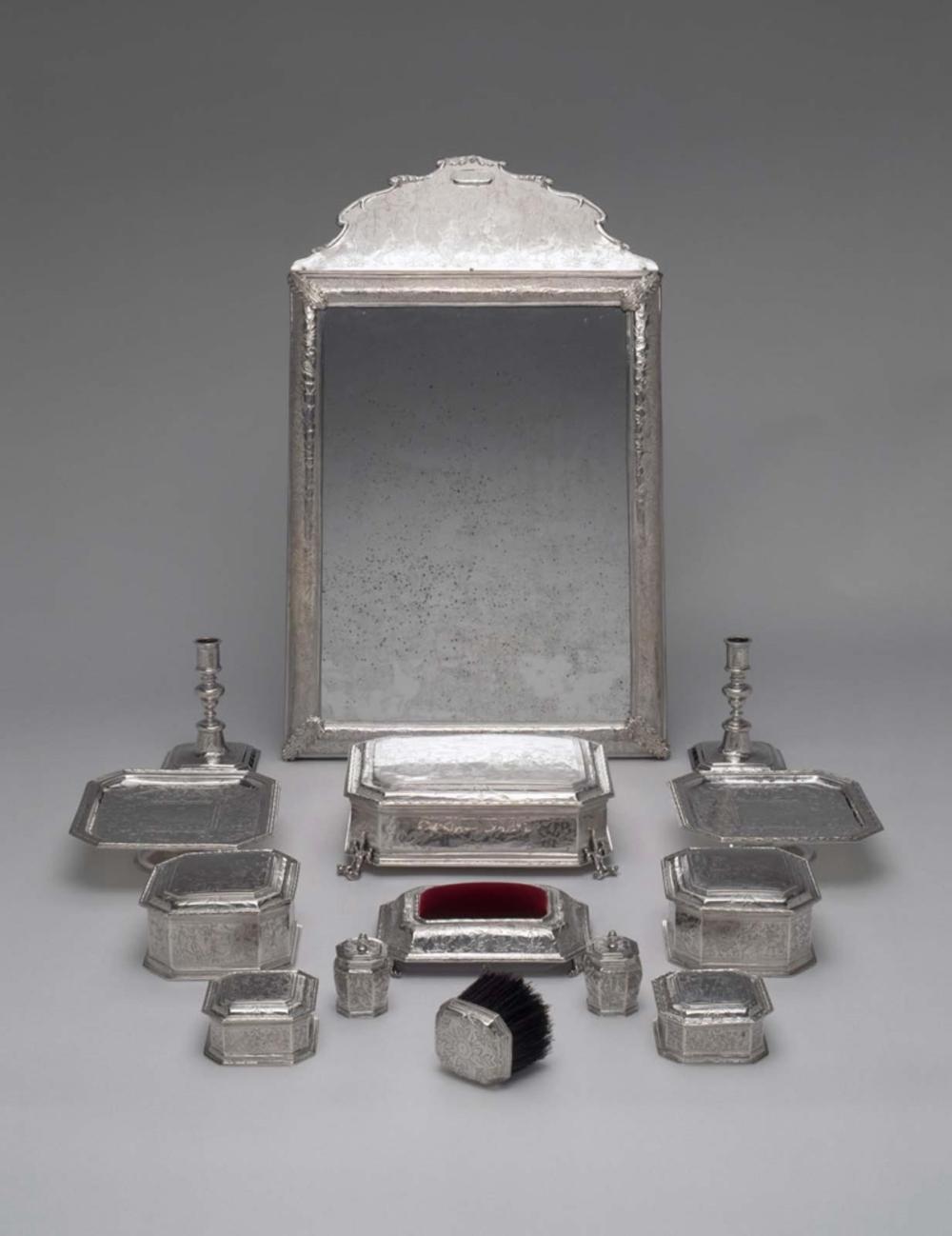Advanced Search 

12-piece Toilet Service
Jacob Bodendeich (German (active in London), 1634–1681)
English
1680
Medium/Technique
Silver with flat-chased decoration; velvet; animal bristles; wood
Dimensions
Overall (salvers): 20 x 20 x 5 cm (7 7/8 x 7 7/8 x 1 15/16 in.)
Overall (pomade pots): 7 x 5 x 5 cm (2 3/4 x 1 15/16 x 1 15/16 in.)
Overall (mirror): 73.5 x 45 cm (28 15/16 x 17 11/16 in.)
Overall (casket): 27.5 x 21 x 8 cm (10 13/16 x 8 1/4 x 3 1/8 in.)
Overall (boxes): 14 x 14 x 7.5 cm (5 1/2 x 5 1/2 x 2 15/16 in.)
Overall (small boxes): 9.3 x 9.3 x 4.2 cm (3 11/16 x 3 11/16 x 1 5/8 in.)
Overall (pin cushion): 20 x 15 x 4 cm (7 7/8 x 5 7/8 x 1 9/16 in.)
Overall (brush): 14 x 14 x 7.5 cm (5 1/2 x 5 1/2 x 2 15/16 in.)
Overall (pomade pots): 7 x 5 x 5 cm (2 3/4 x 1 15/16 x 1 15/16 in.)
Overall (mirror): 73.5 x 45 cm (28 15/16 x 17 11/16 in.)
Overall (casket): 27.5 x 21 x 8 cm (10 13/16 x 8 1/4 x 3 1/8 in.)
Overall (boxes): 14 x 14 x 7.5 cm (5 1/2 x 5 1/2 x 2 15/16 in.)
Overall (small boxes): 9.3 x 9.3 x 4.2 cm (3 11/16 x 3 11/16 x 1 5/8 in.)
Overall (pin cushion): 20 x 15 x 4 cm (7 7/8 x 5 7/8 x 1 9/16 in.)
Overall (brush): 14 x 14 x 7.5 cm (5 1/2 x 5 1/2 x 2 15/16 in.)
Credit Line
Museum purchase with funds donated anonymously and Jessie and Sigmund Katz Collection, by exchange
Accession Number2002.27.1-12
CollectionsEurope
ClassificationsSilver
This toilet service, one of the earliest and most complete English silver sets known, was apparently made for Elizabeth, the second wife of Sir John Moreton, baronet, of Milbourne St. Andrews, Dorset. Traditionally a woman received a toilet service as part of her trousseau or dowry when she married.
An emblem of status, a silver service stood at the focal point of the aristocratic bedroom, where the toilet took place. During the 17th and 18th centuries, the morning toilet was an elaborate social ritual, lasting two or three hours and attended by guests of both sexes. Assisted by hairdressers, tailors, and valets, the nobleman and woman washed their face and hands, had their hair arranged and powdered, applied cosmetics and perfumes, and dressed. The various boxes of the service contained scented creams, wig and face powder, rouge, jewelry, pins, and gloves.
An emblem of status, a silver service stood at the focal point of the aristocratic bedroom, where the toilet took place. During the 17th and 18th centuries, the morning toilet was an elaborate social ritual, lasting two or three hours and attended by guests of both sexes. Assisted by hairdressers, tailors, and valets, the nobleman and woman washed their face and hands, had their hair arranged and powdered, applied cosmetics and perfumes, and dressed. The various boxes of the service contained scented creams, wig and face powder, rouge, jewelry, pins, and gloves.
DescriptionComprising a pair of salvers, pomade pots, mirror, casket, pair of boxes, pair of small boxes, pin cushion and a brush.
Provenance1680, probably made for Elizabeth Culme (b. about 1645/1650 - d. 1715), second wife of Sir John Morton (d. 1698/1699), 2nd Bt., Milbourne St. Andrews, Dorset; by descent to John Morton's daughter, Anne Morton, wife of Edmund Pleydell (b. 1651 - d. 1726); by descent through the Pleydell family to Mrs. Arnold Foster [see note 1]; May 13, 1964, Mrs. Foster sale, Christie's, London, lot 126, to "Johnson" [see note 2]. Hugh Molyneux (b. 1898 - d. 1972), 7th Earl of Sefton; November 21, 1973, posthumous Earl of Sefton sale, Christie's, London, lot 127, to Wartski (dealer), London. Jaime Ortiz-Patiño (b. 1927 - d. 2013), Malaga, Spain; May 21, 1992, Ortiz-Patiño sale, Sotheby's, New York, lot 155. June, 1993, acquired by The Whiteley Trust, Norfolk, England [see note 3]; June 13, 2000, Whiteley Trust sale, Christie's, London, lot 14, bought in; 2002, sold by the Whiteley Trust to the MFA. (Accession Date: February 27, 2002)
NOTES:
[1] The service descended to Anne Morton's granddaughter, Louisa; to her son, John Mansell (Pleydell); and then to his granddaughter, Mrs. Foster. [2] The two salvers comprised by this service (MFA accession nos. 2002.27.1-2) passed out of the family's possession at an unkown date. They belonged to the dealer How of Edinburgh, and were sold June 10, 1993, through Sotheby's, London, before being acquired by the Whiteley Trust. [3] The service was first lent to the MFA in 1997.
NOTES:
[1] The service descended to Anne Morton's granddaughter, Louisa; to her son, John Mansell (Pleydell); and then to his granddaughter, Mrs. Foster. [2] The two salvers comprised by this service (MFA accession nos. 2002.27.1-2) passed out of the family's possession at an unkown date. They belonged to the dealer How of Edinburgh, and were sold June 10, 1993, through Sotheby's, London, before being acquired by the Whiteley Trust. [3] The service was first lent to the MFA in 1997.
